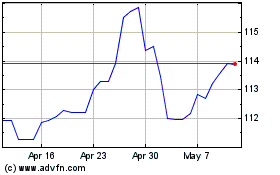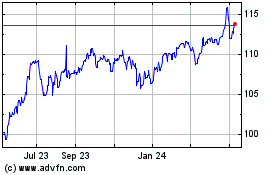ECB's Draghi To Unveil 'Lower For Longer' Tapering
October 25 2017 - 5:59AM
RTTF2
Everyone is waiting with bated breath for the conclusion of the
European Central Bank's policy session on Thursday following which
the bank's chief Mario Draghi is expected to announce a gradual
reduction in the massive monetary stimulus as the euro area
economic growth gains momentum.
Anything less than a move on a gradual reduction in the stimulus
next year would come as a surprise that could unnerve markets,
something that the ECB policymakers are keen to avoid. Recent
rhetoric suggest that there is unanimity in the Governing Council
regarding the trimming of asset purchases.
While a dovish Draghi may omit the word "tapering" in his
statement to cause as little hype as possible, the process of
trimming the monetary stimulus is most likely to be in several
phases as policymakers have already signaled that asset purchases
cannot be stopped abruptly.
The question remains as to how much the bank will reduce the
asset purchases and how long will it take to wind down the entire
stimulus that is now running at EUR 60 billion buys a month till
the end of the year.
"Even though inflation developments could easily argue in favor
of not changing the monetary stance at all, the strong cyclical
upswing together with the scarcity of bonds seems to be the primary
driver for the ECB to announce first details of its tapering
programme finally," ING Bank economist Carsten Brzeski said.
"Or, better describing the ECB's hesitance and caution not to
scare financial markets: the recalibration of its monetary
stance."
Economists widely expect the bank to extend its asset purchases
at a reduced size till September 2018, hence the phrase in focus is
"lower for longer". Some economists put a number on the monthly
asset purchases - EUR 25-30 billion.
If this expectation materializes, it could be the second time
that bank opts for such a move as it had reduced the size of
monthly asset purchases in March this year from EUR 80 billion.
"That [reduction to EUR 25-30 billion] isn't even the start of
an exit from a policy of easy money, since the share of government
bonds held by the ECB will continue to rise next year," Commerzbank
economist Joerg Kraemer said.
"Instead, the ECB needs an exit plan that also incorporates
higher interest rates."
Draghi is also expected to keep the door open for increasing
asset purchases if the outlook worsens and retain the bank's
commitment to unchanged interest rate for a long time, thus
stemming the upward pressure on the euro and bond yields.
In the June policy announcement, Draghi adjusted the forward
guidance to drop the easing bias on interest rates.
Yet, an interest rate hike could be a very long way off. Draghi
is likely to stress on policy "sequencing" asserting that an
increase in interest rates would appear only after the end of asset
purchases in 2018. That does not mean immediately afterwards, but
sometime in 2019, some economists said.
The rate decision announcement is due at 7.45 am ET on Thursday
in Frankfurt and ECB President Draghi is scheduled to hold his
customary post-decision press conference at 8.30 am ET.
The main refi rate is currently at a record low zero percent and
the deposit rate at -0.40 percent. The marginal lending facility
rate is 0.25 percent.
Eurozone inflation was steady at 1.5 percent in September and
the policy-relevant core figure eased marginally to 1.1
percent.
Inflation has stayed away from the ECB's target of "below, but
close to 2 percent" for quite some time. Price growth lost steam
after energy prices cooled.
Meanwhile, the economy has been resilient expanding 0.6 percent
in the second quarter after a 0.5 percent growth in the first three
months of the year. Recent surveys and economic indicators suggest
the momentum continued in the third quarter and is likely to gain
strength in the final three months of the year.
Many hope that the tapering move expected to be announced on
Thursday would be the beginning of the end of ultra-easy monetary
policy since the 2007-08 global financial crisis that saw a daring
Draghi test the limits of unconventional policy by taking deposit
rates to negative territory and buying corporate and state
debt.
A state of high political flux in the euro area was one of the
main reasons that prevented the ECB from thinking in favor of
tapering earlier this year. The German election proved to be a
dampener, but is unlikely to materialize into a serious concern for
the ECB.
Still, political threats to the Eurozone outlook linger, the
latest being Catalonia independence referendum, but the ECB may
have gained more confidence after riding out Brexit and elections
in key euro countries, without much trouble.
CAD vs Yen (FX:CADJPY)
Forex Chart
From Mar 2024 to Apr 2024

CAD vs Yen (FX:CADJPY)
Forex Chart
From Apr 2023 to Apr 2024
